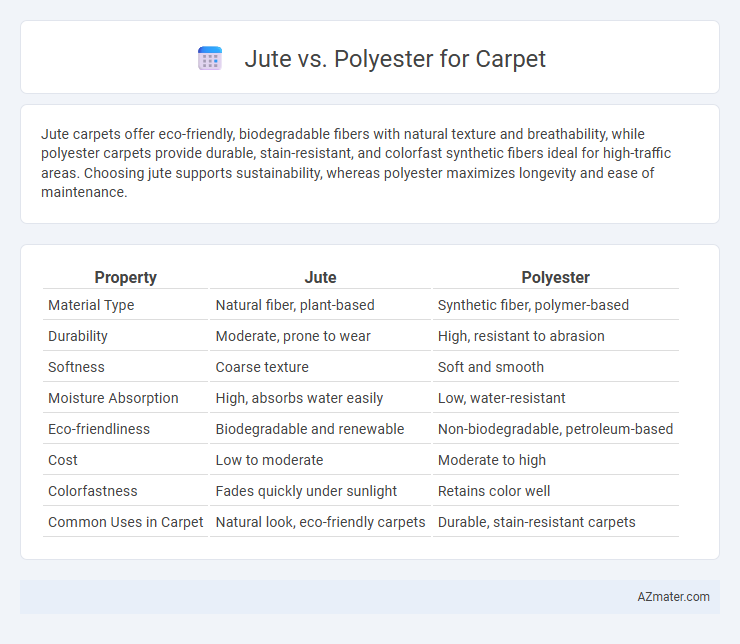Jute carpets offer eco-friendly, biodegradable fibers with natural texture and breathability, while polyester carpets provide durable, stain-resistant, and colorfast synthetic fibers ideal for high-traffic areas. Choosing jute supports sustainability, whereas polyester maximizes longevity and ease of maintenance.
Table of Comparison
| Property | Jute | Polyester |
|---|---|---|
| Material Type | Natural fiber, plant-based | Synthetic fiber, polymer-based |
| Durability | Moderate, prone to wear | High, resistant to abrasion |
| Softness | Coarse texture | Soft and smooth |
| Moisture Absorption | High, absorbs water easily | Low, water-resistant |
| Eco-friendliness | Biodegradable and renewable | Non-biodegradable, petroleum-based |
| Cost | Low to moderate | Moderate to high |
| Colorfastness | Fades quickly under sunlight | Retains color well |
| Common Uses in Carpet | Natural look, eco-friendly carpets | Durable, stain-resistant carpets |
Introduction to Jute and Polyester Carpets
Jute carpets are made from natural fibers derived from the jute plant, offering eco-friendly, biodegradable, and sustainable flooring options with a distinct earthy texture and matte finish. Polyester carpets, composed of synthetic fibers, provide enhanced durability, stain resistance, and vibrant color retention, making them suitable for high-traffic areas. Both materials differ significantly in terms of environmental impact, maintenance requirements, and aesthetic appeal, influencing their selection for residential and commercial applications.
Material Composition: Jute vs Polyester
Jute is a natural fiber derived from the jute plant, known for its eco-friendly and biodegradable properties, making it a sustainable choice for carpets. Polyester, a synthetic polymer made from petrochemicals, offers durability, stain resistance, and vibrant color retention in carpeting applications. Carpets made from jute provide a softer, organic texture, while polyester carpets excel in resilience and easy maintenance due to their synthetic material composition.
Appearance and Texture Comparison
Jute carpets exhibit a natural, coarse texture with a warm, earthy appearance characterized by visible fiber irregularities and a matte finish, enhancing rustic or bohemian interiors. Polyester carpets offer a smoother, more uniform texture with vibrant color retention and a slight sheen, contributing to a modern and polished look. The tactile contrast between jute's rough, organic feel and polyester's soft, synthetic finish influences both aesthetic choice and comfort for flooring applications.
Durability and Longevity
Jute carpets offer natural biodegradability but tend to wear out quickly and are prone to moisture damage, limiting their durability. Polyester carpets, made from synthetic fibers, provide superior resistance to stains, fading, and abrasion, resulting in enhanced longevity. Choosing polyester ensures a more durable carpet suitable for high-traffic areas compared to jute's delicate nature.
Comfort Underfoot
Jute carpets offer a naturally soft and warm texture, providing a comfortable underfoot feel ideal for living spaces. Polyester carpets, while durable and stain-resistant, typically have a smoother and less cushioned surface that may feel firmer underfoot. The natural fibers of jute enhance breathability and softness, making it a preferred choice for comfort-focused carpet applications.
Environmental Impact and Sustainability
Jute carpets offer significant environmental advantages due to their biodegradability and low carbon footprint, as jute is a natural fiber that requires minimal water and pesticides for cultivation. Polyester carpets, typically derived from petrochemicals, contribute to plastic pollution and have a higher energy demand during production, impacting sustainability negatively. Choosing jute over polyester supports eco-friendly flooring options by promoting renewable resources and reducing reliance on synthetic materials.
Maintenance and Cleaning Requirements
Jute carpets require gentle care, as they are sensitive to moisture and prone to mold and mildew, necessitating immediate spill cleanup and regular vacuuming with a soft brush to prevent fiber damage. Polyester carpets offer superior stain resistance and durability, making them easier to clean with standard household detergents and less susceptible to fading or matting. Choosing polyester reduces maintenance frequency and extends carpet lifespan, while jute demands more delicate, frequent attention to maintain its natural texture and appearance.
Cost Differences and Affordability
Jute carpets typically cost less than polyester carpets due to the natural fibers and simpler manufacturing process involved, making them a budget-friendly choice for eco-conscious consumers. Polyester carpets, while generally more expensive, offer enhanced durability and stain resistance, which can translate into long-term savings despite higher initial costs. Affordability depends on balancing upfront investment with expected lifespan and maintenance needs.
Best Applications and Usage Areas
Jute carpets excel in eco-friendly interiors, enhancing natural aesthetics in low-traffic areas like living rooms and bedrooms due to their biodegradability and breathable texture. Polyester carpets offer superior durability and stain resistance, making them ideal for high-traffic commercial spaces, offices, and homes with pets or children. Choosing between jute and polyester depends on balancing sustainability and resilience tailored to specific usage environments.
Final Verdict: Which Carpet Material is Right for You?
Jute carpets offer natural biodegradability, breathability, and a soft texture ideal for eco-conscious buyers seeking sustainable flooring options. Polyester carpets provide superior stain resistance, vibrant color retention, and durability, making them suitable for high-traffic areas and families with pets or children. Choosing between jute and polyester depends on prioritizing environmental impact and aesthetic warmth versus practical wear-resistance and easy maintenance.

Infographic: Jute vs Polyester for Carpet
 azmater.com
azmater.com